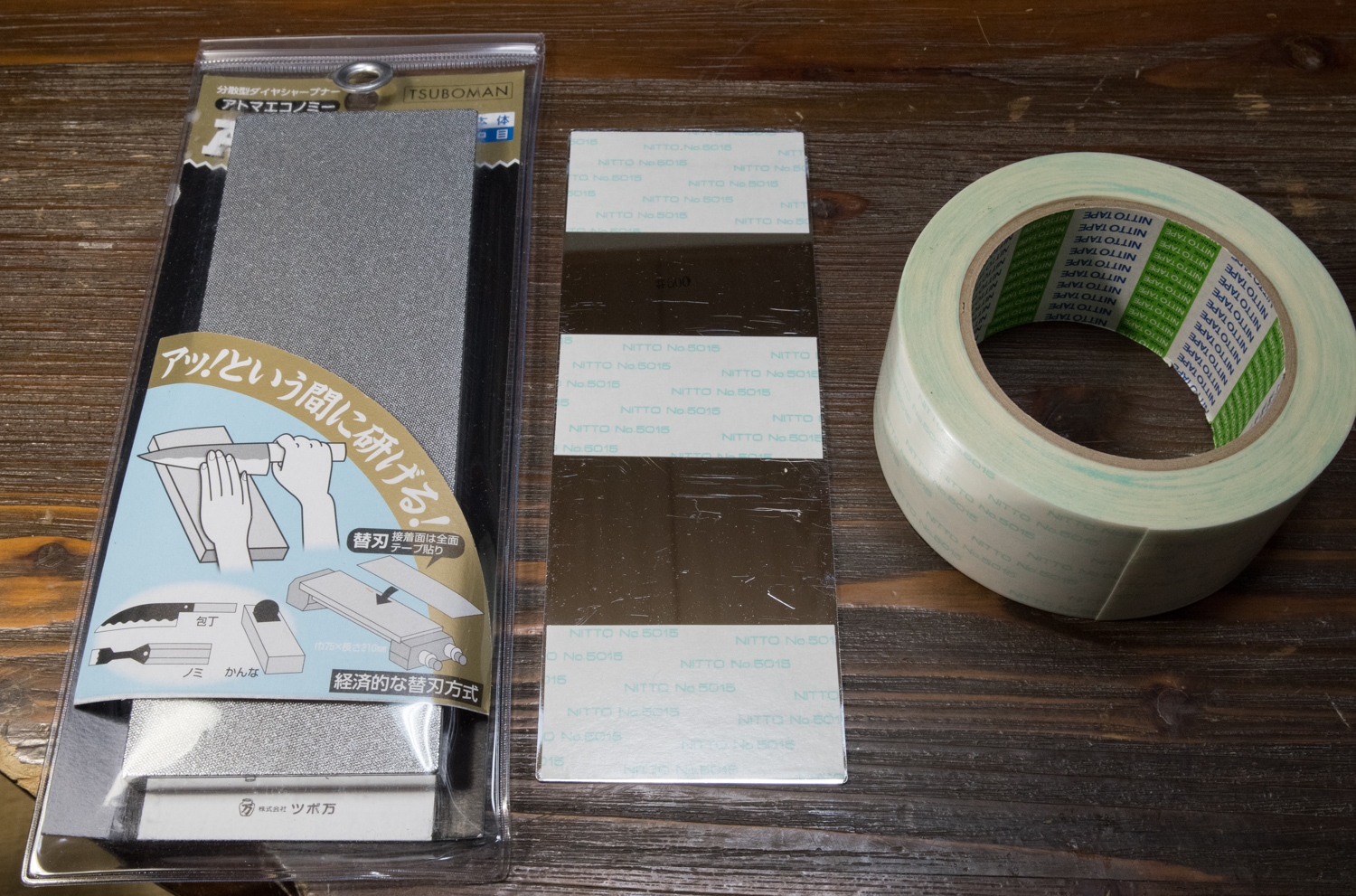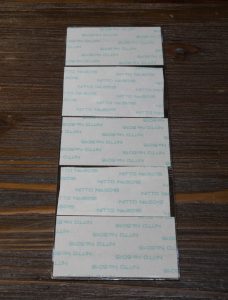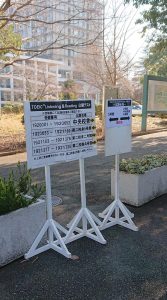第237回のTOEIC L&Rを受けて来ました。通算7回目の受験です。また前回が10月で、こんな短い間隔で受けたのは初めてです。目的は前回のリスニングのリベンジです。今回席が中央の前から2番目というベストポジションで、なおかつ音声の再生機器がいつものラジカセではなく、比較的大きめのスピーカーがついた専用の再生機でした。それもあってか、リスニングはPart 2の問いに対する3択で答えに迷うのが2問ありましたが、公式問題集(2018年10月10日発売の4)のTest 2で非常にトリッキーな問題が出ていたPart 4については今回は比較的平易でした。多分前回よりはいいと思いますが、自己ベストの480に達したかは微妙です。
リーディングも前回とほぼ同じ位の感触で、一応7分ぐらい余して全問解答し、Part 5の30問全部を見なおすことが出来ました。しかし前回は満点の一歩手前の490点だったので今回そこまで取れた自信はありません。
トータルで前回よりはいいと思いますが、自己ベストの965点には多分達していないかな、という感じです。
ちなみに会場は4回目くらいの明大の生田キャンパスです。実はここは戦争中に軍の登戸研究所があった所です。そうです、あの珍兵器の「風船爆弾」を開発した研究所です。もし資料館みたいなものがあるのなら、いつか訪問してみたいです。
日: 2019年1月13日
アトマエコノミーによる砥石の面直し

 砥石の面直しには、ツボ万のアトマエコノミーという、アルミのベースに、ダイヤモンド電着砥石を貼り付けたものを使っています。面直し用の砥石ももちろん持っていますが、それ自体が使っている内に変形して平面が出なくなるので、大まかに修正するまではそちらを使いますが、最終的な平面出しはアトマエコノミーが一番便利です。これはベースが厚いアルミの板なんで、平面性が大きく狂うことはありません。私は1回砥石を使ったら、必ずアトマエコノミーで面の修正をします。最終的に砥石の表面の平面度を確認するには、ストレートエッジというステンレス製の平面確認用定規を使います。(簡易的にはただのステンレス製の定規でも使えます。)
砥石の面直しには、ツボ万のアトマエコノミーという、アルミのベースに、ダイヤモンド電着砥石を貼り付けたものを使っています。面直し用の砥石ももちろん持っていますが、それ自体が使っている内に変形して平面が出なくなるので、大まかに修正するまではそちらを使いますが、最終的な平面出しはアトマエコノミーが一番便利です。これはベースが厚いアルミの板なんで、平面性が大きく狂うことはありません。私は1回砥石を使ったら、必ずアトマエコノミーで面の修正をします。最終的に砥石の表面の平面度を確認するには、ストレートエッジというステンレス製の平面確認用定規を使います。(簡易的にはただのステンレス製の定規でも使えます。)
アトマエコノミーは元々は片面の製品ですが、私は替え刃も一緒に買って両面にしています。そして両方の面の荒さを変えていて、今回買ったのは中目と細目の組み合わせです。まず中目で平面出しして、それを細目でもう1回処理して仕上げます。
問題は価格で、かなり高くて「エコノミー」という名前はどこがそうなのか理解に苦しみます。ダイヤモンド電着砥石の部分がすり減ったら、替え刃を買って差し替えればエコノミーですよ、ということなのかもしれませんが、
アトマエコノミー 本体(中目) ¥5,899
アトマエコノミー 替刃(細目) ¥5,000
という値付けでは替え刃もほとんど本体と値段が変わりません。
それから、もう一つの些細な問題は、替え刃の裏に両面テープが付いているのですが、これがちゃんと全面を覆っているものと、今回買ったみたいに、部分的にしか覆っていないものがあることです。まあ替え刃自体も薄いアルミ板を使っているので、部分的な接着でいいのかもしれませんが、平面出しという目的では気持ちが悪いので、私はAmazonでわざわざ同じ両面テープ(日東 多用途両面接着テープ No.5015 50mm×20m 501550)を買って、全面的に両面テープを付けて接着しています。
New Year’s traditions in Japan
The following is my essay that I wrote as an assignment for an English school AEON:
Topic: New Year’s traditions in Japan
Style: Casual
There were a bunch of rituals, ceremonies, and customs related to New Year’s holidays. Most of them are currently lost in many families, but there is one area where a long tradition is still vital: food. The most important special food for a new year is mochi, or rice cake. Mochi is made from a special type of rice that is stickier than the usual type. We steam that rice and put it in a stone bowl and hit it by wooden beetles for say, 10 to 15 minutes. The rice is crushed enough to become like a pudding. Then we pick some apart and make it round (the way in the western part of Japan) or cut it with a big knife (the way in the eastern part of Japan). While the form of mochi in the western part of Japan is round, it is rectangular in the eastern part. The round form was the original, but the eastern type rectangular form was introduced to cope with increased population in Edo (the former name of the Tokyo city) to save time. Since I was born in Yamaguchi prefecture that is located in the west end of Honshu island. I was surprised very much when I saw rectangular mochi in Tokyo for the first time.
There are several ways to cook and eat mochi, but the most typical and important dish to use mochi is zoni, special soup with mochi. Zoni is prerequisite for the first three days of the New Year for breakfast. I just mentioned the difference of the form of mochi, but there are tens of hundreds of ways to cook zoni. When a newly married couple, each coming from different areas in Japan, holds a New Year ceremony together for the first time, one of the most troublesome things is how to cook zoni. Each has a completely different image for zoni, and since zoni is a very special and important dish for a New Year, it may cause a lot of trouble between the couple. Not mentioning the form of mochi, there are also two ways to prepare mochi for zoni: to bake or to boil it. There are also several types of soup such as soy source based, soy bean paste (miso) based, and in some limited area they use ‘sweet’ soup using red bean paste.
When I was living in Tokushima, there was an exhibition in a local museum regarding the types of zoni in the Tokushima prefecture. Since Tokushima (Awa) was governed by Hachisuka family came from Aichi prefecture, there are some families that use rectangular mochi while round mochi is popular in Tokushima which locates in the western part of Japan. There were actually almost forty or fifty different types of zoni in the prefecture. One thing that surprised me was that there are some people living in deep mountain area who eat soba noodle instead of zoni since they cannot plant rice because of cold weather.
Now, I usually spend New Year holidays travelling. It is always interesting to try a new type of zoni in different areas.

